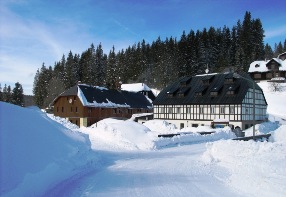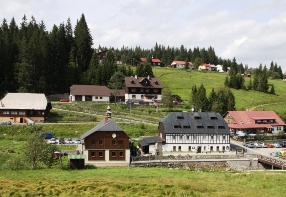Binert Sawmill
The Prince of Schwarzenberg bought from the Earl Kinský the Prášily estates (including the village of Modrava) in 1798 to exploit the wealth of timber from the local forests. The timber of the slowly growing Šumava spruces had a special feature - the resonance - thus making it suitable for the production of sound boards used in the construction of musical instruments. The entrepreneur Franz Bienert (born on 4th February 1788 in Horní Chřibská) took the opportunity of this fact and bought an older sawmill standing on the left bank of the Roklanský stream from the estates owner Joseph of Schwarzenberg in 1827, which he rebuilt into the plant manufacturing sound boards. Together with the sawmill, Bienert also bought the neighbouring building of the Schwarzenberg's hunting lodge.
In 1832, Franz Bienert received the Emperor's privilege on the exclusive production of the resonant timber for the period of ten years, another one on the improved manufacturing procedure and a separate privilege on the production of riddle ribs. The original timber consumption amounted at 500 cubic metres per year, later at about 1000 cubic metres per year. The manufacturing procedure was as follows: the trees were cut in winter, afterwards the logs were chopped, in spring they were soaked for several weeks, dried and fine-chopped for stringed instruments or cut in sound boards for the pianos. Afterwards it was soaked once again for four weeks, dried and sun-blanched. The products were exported to the whole of Europe and America.
In 1855 Bienert founded another similar plant in Stožec. he was employing about 50-100 people at the sawmill and in the forest for the purposes of the Modrava plant at the time. The privileges granted to him were repeatedly extended for two-year periods until his death (1st February 1866) when his wife took over the management of both plants. Production was nevertheless steeply dropping down due to the fierce competition and after the strong wind-storm of 1870 that destroyed vast areas of the forests, Mrs. Bienert sold the factory to Schwarzenberg in 1871, who transferred the whole production to Stožec in 1880.
All the factory buildings are nowadays listed by the National Heritage Institute as immovable cultural monuments.
In 1832, Franz Bienert received the Emperor's privilege on the exclusive production of the resonant timber for the period of ten years, another one on the improved manufacturing procedure and a separate privilege on the production of riddle ribs. The original timber consumption amounted at 500 cubic metres per year, later at about 1000 cubic metres per year. The manufacturing procedure was as follows: the trees were cut in winter, afterwards the logs were chopped, in spring they were soaked for several weeks, dried and fine-chopped for stringed instruments or cut in sound boards for the pianos. Afterwards it was soaked once again for four weeks, dried and sun-blanched. The products were exported to the whole of Europe and America.
In 1855 Bienert founded another similar plant in Stožec. he was employing about 50-100 people at the sawmill and in the forest for the purposes of the Modrava plant at the time. The privileges granted to him were repeatedly extended for two-year periods until his death (1st February 1866) when his wife took over the management of both plants. Production was nevertheless steeply dropping down due to the fierce competition and after the strong wind-storm of 1870 that destroyed vast areas of the forests, Mrs. Bienert sold the factory to Schwarzenberg in 1871, who transferred the whole production to Stožec in 1880.
All the factory buildings are nowadays listed by the National Heritage Institute as immovable cultural monuments.


